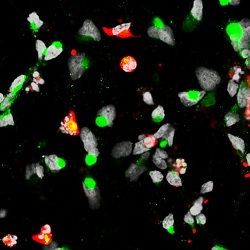Likely Biological Link Found Between Zika Virus, Microcephaly
(Originally published by Johns Hopkins)
March 04, 2016
Working with lab-grown human stem cells, a team of researchers suspect they have discovered how the Zika virus probably causes microcephaly in fetuses. The virus selectively infects cells that form the brain’s cortex, or outer layer, making them more likely to die and less likely to divide normally and make new brain cells.

The researchers say their experiments also suggest these highly-susceptible lab-grown cells could be used to screen for drugs that protect the cells or ease existing infections.
“Studies of fetuses and babies with the telltale small brains and heads of microcephaly in Zika-affected areas have found abnormalities in the cortex, and Zika virus has been found in the fetal tissue,” says Guo-li Ming, M.D., Ph.D., a professor of neurology, neuroscience, and psychiatry and behavioral science at Johns Hopkins’ Institute for Cell Engineering. “While this study doesn’t definitely prove that Zika virus causes microcephaly, it’s very telling that the cells that form the cortex are potentially susceptible to the virus, and their growth could be disrupted by the virus.” Ming led the research team along with Hongjun Song, Ph.D., a professor of neurology and neuroscience in the Institute for Cell Engineering, and Hengli Tang, Ph.D., a virologist at Florida State University. Ming and Song are also members of the new Kavli Neuroscience Discovery Institute at Johns Hopkins.
Results of the experiments, conducted by researchers at the Johns Hopkins University School of Medicine, Florida State University, and Emory University, are described online March 4 in the journal Cell Stem Cell.
In a fast-paced study that reflects the global public health threat posed by Zika, the researchers compared Zika’s effect on cells known as cortical neural progenitor cells to two other cell types: induced pluripotent stem cells and immature neurons. Induced pluripotent stem cells are made by reprogramming mature cells, and can give rise to any cell type in the body, including cortical neural progenitor cells. Cortical neural progenitor cells in turn give rise to immature neurons.
The experiments, conducted in less than a month, began when Tang reached out to Ming and Song, who use stem cells to study early brain development. The Johns Hopkins labs sent team members and cells to Tang’s lab, where the cells were exposed to Zika virus. Then the cells’ genetic expression – evidence of which genes were being used by the cells and which weren’t – were analyzed in Peng Jin’s laboratory at Emory University.
According to Tang, three days after exposure to the virus, 90 percent of the cortical neural progenitor cells were infected, and had been hijacked to churn out new copies of the virus. Furthermore, the genes needed to fight viruses had still not been switched on, which is highly unusual, he adds. Many of the infected cells died, and others showed disrupted expression of genes that control cell division, indicating that new cells could not be made effectively.
Using specific, known types of cells allowed the researchers to see where the developing brain is most vulnerable, Song says. He and Ming are now using the cells to find out more about the effects of Zika infection on the developing cortex. “Now that we know cortical neural progenitor cells are the vulnerable cells, they can likely also be used to quickly screen potential new therapies for effectiveness,” Song adds.
Zika virus has recently emerged as a public health concern, but it was first discovered in Uganda in the 1940s. Since then, small outbreaks have appeared in Asia and Africa, but symptoms were generally mild and did not appear to have any long-term effects. Carried by infected Aedes aegypti mosquitos, Zika is largely transmitted through bites, but can also occur through intrauterine infection or sexual transmission.
In 2015, the Zika virus began spreading throughout the Americas and a potential link was seen between the virus and a significant increase in cases of fetal microcephaly, as well as other neurologic abnormalities. This connection and the proliferation in cases led to the World Health Organization declaring Zika virus an international public health emergency.
Link to the paper: http://www.cell.com/cell-stem-cell/fulltext/S1934-5909(16)00106-5
Other authors of the study are Christy Hammack, Sarah Ogden, Emily Lee and Ruth Didier of Florida State University; Zhexing Wen, Xuyu Qian, Jaehoon Shin and Kimberly Christian of Johns Hopkins University; and Yujing Li, Bing Yao and Feiran Zhang of Emory University.
The study was funded by Florida State University; the National Institute of Allergy and Infectious Disease (grant numbers AI119530 and AI111250), the National Institute of Neurological Disorders and Stroke (grant numbers NS048271, NS095348, NS047344, NS051630 and NS079625); and the Maryland Stem Cell Research Fund. Hongjun Song and Guo-li Ming are members of the Kavli Neuroscience Discovery Institute.